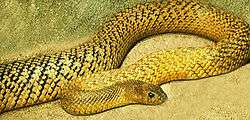Taipan
| Taipan | |
|---|---|
 | |
| Inland taipan (Oxyuranus microlepidotus) | |
| Scientific classification | |
| Kingdom: | Animalia |
| Phylum: | Chordata |
| Subphylum: | Vertebrata |
| Class: | Reptilia |
| Order: | Squamata |
| Suborder: | Serpentes |
| Family: | Elapidae |
| Genus: | Oxyuranus Kinghorn, 1923[1] |
The taipans are snakes of the genus Oxyuranus in the elapid family. They are large, fast-moving, highly venomous, and endemic to Australasia. There are currently three recognized species, one of which, the coastal taipan, has two subspecies. The taipans are considered some of the most deadly known snakes.
Etymology

The common name, taipan, was coined by anthropologist Donald Thomson after the word used by the Wik-Mungkan Aboriginal people of central Cape York Peninsula, Queensland, Australia.[2]
Species and geographic ranges
The three known species are: the coastal taipan (Oxyuranus scutellatus), the inland taipan (Oxyuranus microlepidotus), and a recently discovered third species, the Central Ranges taipan (Oxyuranus temporalis).[3] The coastal taipan has two subspecies: the coastal taipan (O. s. scutellatus), found along the northeastern coast of Queensland, and the Papuan taipan (O. s. canni), found on the southern coast of Papua New Guinea.
Diet
Their diets consist primarily of small mammals, especially rats and bandicoots.
Venom
Species of this genus possess highly neurotoxic venom with some other toxic constituents that have multiple effects on victims. The venom is known to paralyze victim's nervous system and clot the blood, which then blocks blood vessels and uses up clotting factors. Members of this genus are considered to be among the most venomous land snakes based on their murine LD50, an indicator of the toxicity on mice. The inland taipan is considered to be the most venomous land snake and the coastal taipan, which is arguably the largest Australian venomous snake, is the third-most venomous land snake.[4] The central ranges taipan has been less researched than other species of this genus, so the exact toxicity of its venom is still not clear, but it may be even more venomous than the other taipan species.[5] Apart from venom toxicity, quantities of venom delivered should also be taken into account for the danger posed. The coastal taipan is capable of injecting a large quantity of venom due to its large size.[6]
In 1950, Kevin Budden, an amateur herpetologist, was one of the first people to capture a taipan alive, although he was bitten in the process and died the next day.[7] The snake, which ended up dying a few weeks later, was milked by Melbourne zoologist David Fleay and its venom used to develop an antivenom, which became available in 1955.[8][9]
Temperament also varies from species to species. The inland taipan is generally shy while the coastal taipan can be quite aggressive when cornered and will actively defend itself.[6]
Taxonomy
| Species | Taxon author[10] | Subspecies | Common name |
|---|---|---|---|
| Oxyuranus microlepidotusT | (F. McCoy, 1879) | 0 | Inland taipan |
| Oxyuranus scutellatus | (W. Peters, 1867) | 2 | Coastal taipan |
| Oxyuranus temporalis | Doughty et al., 2007 | 0 | Central Ranges taipan |
References
- ↑ ITIS (Integrated Taxonomic Information System). www.itis.gov.
- ↑ Sutton, Peter (1995). Wik Ngathan Dictionary.
- ↑ Doughty, P.; Maryan, B.; Donnellan, S. & Hutchinson, M. (2007). "A New Species of Taipan (Elapidae: Oxyuranus) from Central Australia" (PDF). Zootaxa. 1422: 45–58.
- ↑ Thomas, Séan & Griessel, Eugene (December 1999). "LD50". seanthomas.net.
- ↑ "One of the Most Venomous Snakes in the World – Oxyuranus temporalis." International Institute for Species Exploration, 2008.
- 1 2 "IMMEDIATE FIRST AID for bites by Australian Taipan or Common Taipan". Archived from the original on 2012-04-02.
- ↑ "80-Year-Old Vintage Snake Venom Can Still Kill". January 2014. Retrieved 16 January 2014.
- ↑ "Taipan "belonga devil"". News. Adelaide, South Australia. 1 August 1950. p. 11. Retrieved 16 January 2014.
- ↑ Williams, David (January 2004). "The Death of Kevin Budden". Retrieved 16 January 2014.
- ↑ The Reptile Database. www.reptile-database.org.
Further reading
- Kinghorn, J.R. 1923. A New Genus of Elapine Snake from Northern Australia. Records of the Australian Museum 14 (1): 42–45 + Plate VII.
("Oxyuranus, gen. nov.", p. 42.)
External links
| Look up taipan in Wiktionary, the free dictionary. |
- Barnett, Brian. "Keeping and Breeding the Coastal Taipan (Oxyuranus scutellatus)." Journal of the Victorian Herpetological Society, 10 (2/3), 1999 (pages 38–45).
- "Coastal Taipan," the Australian Reptile Online Database, www.arod.com.au
- "Inland Taipan," the Australian Reptile Online Database, www.arod.com.au